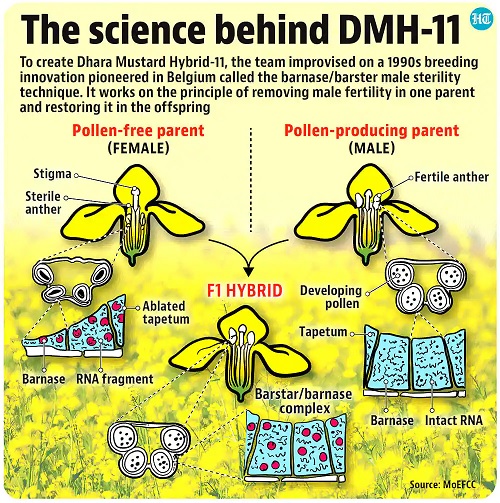Transgenic hybrid mustard DMH-11
Context
-
The Genetic Engineering Appraisal Committee (GEAC) under the Union Ministry of Environment, Forest and Climate Change recommended the “environmental release” of the transgenic hybrid mustard DMH-11 for seed production and conduct of field demonstration studies with respect to its effects, if any, on honey bees and other pollinating insects.
What exactly is hybrid mustard?
- Hybridisation involves crossing two genetically dissimilar plant varieties that can even be from the same species.
- The first-generation (F1) offspring from such crosses tend to have higher yields than what either parent can individually give.
- Such hybridisation isn’t easy in mustard, as its flowers have both female (pistil) and male (stamen) reproductive organs, making the plants largely self-pollinating.

Photo Credit: MoEFCC - Since the eggs of one plant cannot be fertilised by the pollen grains from another, it limits the scope for developing hybrids unlike in cotton, maize or tomato, where this can be done through simple emasculation or physical removal of anthers.
So, how has hybridisation been achieved in mustard?
- By genetic modification (GM). Scientists at Delhi University’s Centre for Genetic Manipulation of Crop Plants (CGMCP) have developed the hybrid mustard DMH-11 containing two alien genes isolated from a soil bacterium called Bacillus amyloliquefaciens.
- The first gene (‘barnase’) codes for a protein that impairs pollen production and renders the plant into which it is incorporated male-sterile.
- This plant is then crossed with a fertile parental line containing, in turn, the second ‘barstar’ gene that blocks the action of the barnase gene.
- The resultant F1 progeny is both high-yielding and also capable of producing seed/ grain, thanks to the barstar gene in the second fertile line.
- The CGMCP scientists have deployed the barnase-barstar GM technology to create what they say is a robust and viable hybridisation system in mustard.
- This system was used to develop DMH-11 by crossing a popular Indian mustard variety ‘Varuna’ (the barnase line) with an East European ‘Early Heera-2’ mutant (barstar).
- DMH-11 is claimed to have shown an average 28% yield increase over Varuna in contained field trials carried out by the Indian Council of Agricultural Research (ICAR).
What has GEAC now done?
- GEAC is a body responsible for appraisal of proposals relating to the “release” of GM organisms and products (ordinarily considered hazardous) into the environment.
- In this case, it has recommended the environmental release of DMH-11 “for its seed production and testing…prior to commercial release”.
- In other words, it has given the green signal for commercial cultivation by farmers, with production of seed material being the first step.
- GEAC has also recommended the environmental release of DMH-11’s parental lines (carrying the barnase and barstar genes) for them to be used to develop new hybrids.
- Such hybrids could give even higher yields than DHM-11.
- Mustard varieties in India have a narrow genetic base.
- The barnase-barstar system enables breeding of hybrids from a wider range of mustards, including those of East European origin such as ‘Heera’ and ‘Donskaja’.
Why did it take so long for GEAC to clear?
- In GM mustard, there have been two specific concerns voiced as well.
- The first is the presence of a third ‘bar’ gene, which makes GM mustard plants tolerant to the spraying of glufosinate ammonium, a chemical used for killing weeds. This, the opponents allege, will cause displacement of manual labour engaged in weeding by promoting use of chemical herbicides.
- The second concern is over GM mustard threatening or undermining the population of honey bees. Mustard flowers are a source of nectar for honey bees and many other pollinator insects.
Reference:
https://indianexpress.com/article/explained/understanding-gm-mustard-8231981/
Visit Abhiyan PEDIA (One of the Most Followed / Recommended) for UPSC Revisions: Click Here
IAS Abhiyan is now on Telegram: Click on the Below link to Join our Channels to stay Updated
IAS Abhiyan Official: Click Here to Join
For UPSC Mains Value Edition (Facts, Quotes, Best Practices, Case Studies): Click Here to Join
